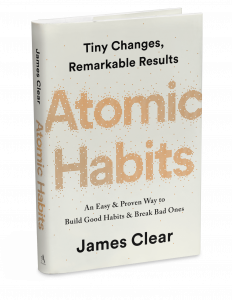Change – The Power of Applied Behavioral Analysis and Positive Language

Make Life Meaningful
Many of us get stuck in a cycle of maintaining undesirable habits with negative effects. Individuals often struggle to commit to change. So, how can naturally reinforced habits be broken? Through the use of Applied Behavior Analysis (ABA) principles and positive language, we  increase the likelihood of making our goals into habits. A helpful tool in the journey for a healthy lifestyle is James Clear’s Atomic Habits. In his book, Clear discusses the four laws of behavior change. In this post, we’ll review these laws and how we can use them to achieve lifestyle changes.
increase the likelihood of making our goals into habits. A helpful tool in the journey for a healthy lifestyle is James Clear’s Atomic Habits. In his book, Clear discusses the four laws of behavior change. In this post, we’ll review these laws and how we can use them to achieve lifestyle changes.
Four Laws of Behavior Change
In the First Law of Behavior Change, Clear addresses the importance of creating a desirable habit and breaking an undesirable one. When forming a desirable habit, the First Law seeks to make the behavior obvious. A person must be aware of her habit and identify environmental factors that reinforce the behavior.
For example, an individual seeking to reduce clutter could implement intentions by saying, “I will clean my bedroom at noon.” She could stack this habit with a second habit and say, “After I clean, I will donate/toss away unnecessary and unused items.” Habit stacking allows the individual to continue establishing the habit while creating a positive environment. It is vital to remember that positive habits will not have lasting effects in a negative or conflicting environment.
And in the Second Law of Behavior Change, we learn the effects of making a behavior attractive. To make a behavior attractive or increase the likelihood of its occurrence, we should reward our successes. Habits are attractive when associated with positive feelings, so people must connect positive habits with positive experiences.
people must connect positive habits with positive experiences.
For instance, the thought of cleaning may be aversive, but the reward is an intrinsically motivating sense of satisfaction and possibly an additional reward like ice cream or hosting a social gathering. The reward applies specifically to each individual, so people must explore their interests and figure out the best reward. However, the reward cannot be counterproductive to the initial goal; therefore, a person seeking to maintain a decluttered and clean environment would not benefit from utilizing a reward of purchasing clothes or home décor.
The Third Law of Behavior Change teaches us the importance of making a habit easy. The repetition of a behavior strengthens the behavior and forms a habit. Time is not a considerable measurement tool; instead, individuals must measure their habits by ratio. The number of times a behavior occurs is more significant than the amount of time elapsed. While repetition is important, one must ensure the consequence (reward) is motivating.
Reinforcing behavior is essential to behavior change. When the repetition or likelihood of a behavior is increased, then it is reinforced. If there is no change or a decrease in behavior, then the preferred item is not a reinforcer; thus, the behavior one is trying to achieve is less likely to be reached. This principle plays into the next law of behavior change we will review.
Finally, the Fourth Law of Behavior Change emphasizes making behavior satisfying to increase repetition. As mentioned above, reinforcement seeks to increase behavior. Contrastingly, punishment aims to decrease behavior. People prefer to receive gratification immediately, yet modern society shifted to a delayed-return environment. If the individual who needs to declutter enjoys hosting social gatherings (her reward), then she will be more likely to keep a tidy space.
This person may also consider implementing an antecedent intervention commonly known as “First/Then.” This intervention is useful for establishing a schedule and setting the occasion for the reward. For example, the person who needs to clean would say, “First, I will clean the living room. Then, I can invite friends over for dinner.” James Clear’s Atomic Habits is a useful tool for behavior change, but it is not the only method to create a productive lifestyle.
About the Self-Management Program
Another approach to behavior change is to create a self-management program. The necessary steps to make a self-management program include identifying a goal, identifying and defining the behavior that needs to change, setting rules and procedures, enacting various contingencies (daily, weekly, long-term), and finding a self-management partner.
Below is a short template, paired with an example, to assist in creating a self-management program.
 Goal: I wish to increase intake of plant-based foods and not to eat meat.
Goal: I wish to increase intake of plant-based foods and not to eat meat.
Behavior Change Needed to Achieve Goal: I need to eliminate purchasing meat and select dairy products. I purchased a cookbook to assist me in preparing for the change.
Rules and Procedures: I must only purchase vegetarian products. I will set an alarm to prepare my meals and snacks for the week on Sunday nights at 8:00PM, packing them into containers.
I will also set an alarm for 6:15PM on Thursdays to pick the meals for the next week. I will leave the cookbook on my nightstand, which is also where I store my electronics.
Immediate Contingencies/Consequences: By preparing my snacks and meals in advance, I have primed my daily rituals/habits. When the Sunday alarm goes off, I will be reminded to prepare my food for the week. When the Thursday alarm goes off, I will have direct access to the book, as it will likely be next to me. I plan to leave the cookbook on my nightstand with my electronics because I will see it more often. It will also serve as a visual cue to prepare my meals. When I am home, I spend most of my time in my bedroom doing schoolwork or finishing session notes.
Daily Contingencies/Consequences: If my daily goal to maintain a vegetarian lifestyle is achieved, then I can have a desired frozen dessert at the end of the day.
Weekly Contingencies/Consequences: If I eat a vegetarian diet consecutively for three days, then I can eat out the following weekend. I can only eat items fitting the criteria. I created a list of restaurant options suitable for this plan.
Long-Term Consequences: Previously, when I maintained this lifestyle, I had better sleep, more energy, and felt like I was performing better overall. I believe I will experience similar effects if I implement this plan.
Self-Management Partner: My self-management partner will be one of my friends who has a restricted diet. She is knowledgeable about this topic, and we often eat the same foods. Additionally, she is supportive of me making this change while others in my life are not.
Be Aware of the Language You Use
In all, it is possible to break an undesirable habit and replace it with a desirable one. Be aware of the language you are utilizing as you set yourself up for a behavior change.
For example, the term “diet” can have negative connotations; therefore, you may consider using a positive approach and deeming it a lifestyle change. Language is powerful. ABA is powerful. Use both to achieve the impossible.
Share your thoughts or comments about this post – we’d love to hear from you.
Contributed by:
Bailey McLaughlin
Bailey McLaughlin is a Registered Behavior Technician (RBT) and is currently working towards her board certification in behavioral analysis with Beyond Autism Services in Media, Pennsylvania. She provides Applied Behavior Analysis (ABA) services to individuals with autism in various settings like home, school, community, and clinical.
Bailey earned a bachelor’s degree in Psychology from Gwynedd Mercy University and a master’s degree in School Psychology from Philadelphia College of Osteopathic Medicine. In her master’s program, the Philadelphia College of Osteopathic Medicine bestowed Bailey with the Provost’s Award, signifying academic excellence and a dedication to youth advocacy. She strives to educate others on the benefits of ABA and how implementing positive language and behavioral procedures can create meaningful, lasting change.
Leave a Comment
